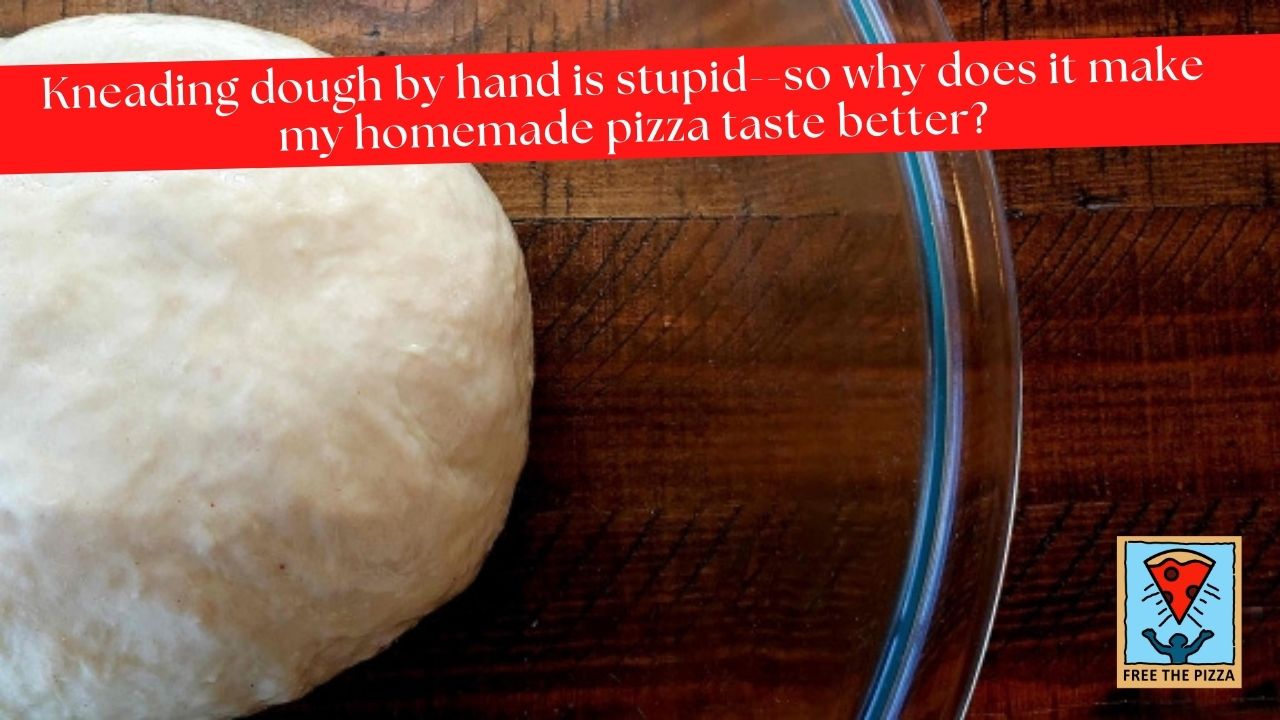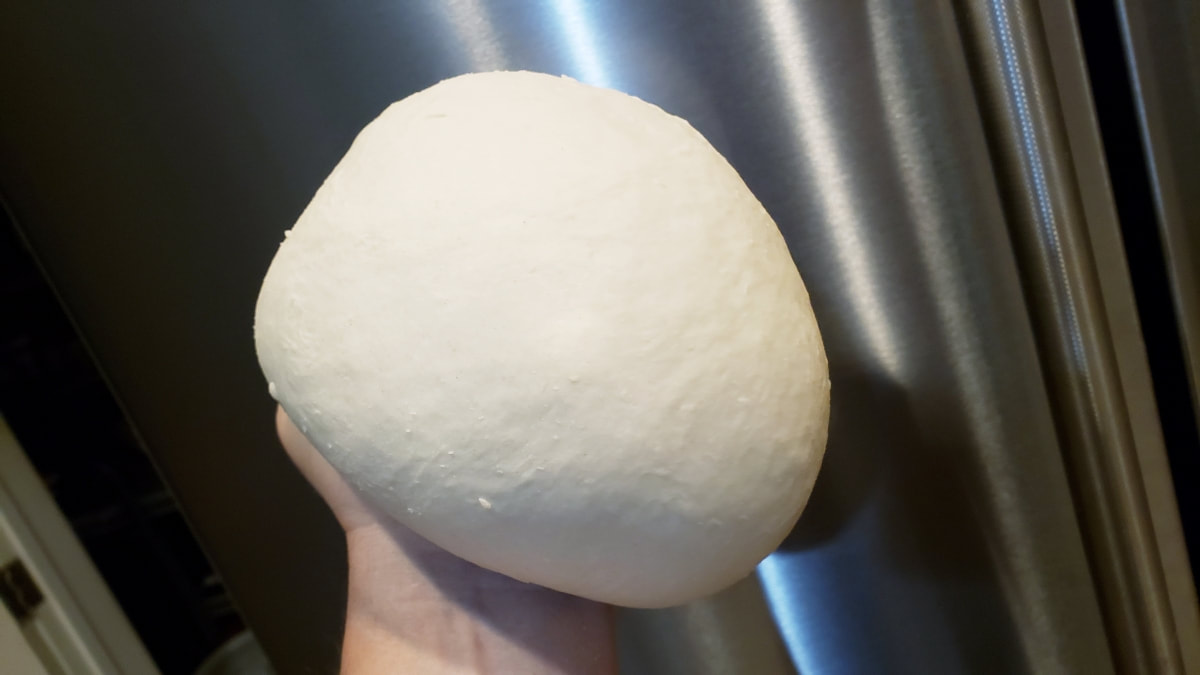 (ABOVE: Gratuitous image of a dough ball kneaded by hand, then placed in a glass bowl on an imitation walnut tabletop for maximum photogenic contrast.) Some people will tell you that kneading pizza dough by hand is a dumb idea. Look at all the dough-mixing technology around you! Food processors! Stand mixers! Planetary mixers! Hell, why are you even making your own dough? Buy it premade! There's perfectly good dough to be had in the supermarket! (You can see the slippery slope here. Soon, you're just buying the pizza of shame from a national pizza delivery chain, eating it in the dark and crying into your Chianti.) I don't know how to say this, but... Ever since I started keading my dough by hand, my pizza has improved immensely. This is not scientific fact. It is merely anecdotal evidence. But the two things that have made my pizza the stuff of epic poetry are a) handmade dough, and b) baking steel. (And even if you won't stop using your modernistically convenient, electric-powered dough-kneading device, get steel. Even my wife, who doesn't cook much at all, likes telling people, "Oh, yeah. The steel changes everything!" Bake with steel--it gets far hotter than stone.) For kneading by hand, it helps if you learn to enjoy the process. And one of the ways to enjoy it is by developing a simple system of kneading, and then embracing it. Remember that pizza dough is alive, and it does great things for you. Pizza dough is your friend. I mean, it's not going to drive you to the airport or do your taxes or anything like that. But it will make you and everyone to whom you serve your pizza very, very happy. So when you’re making dough, you really are making a friend of sorts. I used to use a stand mixer all the time, and now I prefer not to. And that's not because my mixer broke and I'm too cheap to replace it. (Which could happen. After all, I do come from New England, and I also have Scottish genes. I get a double-whammy in the thrift department: both genetic and conditioned cheapness.) I do find that I make a better dough when kneading by hand. And this despite the science out there telling me I’m wrong. And I suspect that part of this is due to the fact that I developed a simple, fluid method of kneading that goes for maximum effect as well as maximum efficiency. The hand-kneading frenzy starts by combining the ingredients and adding water, and stirring it all into a shaggy, wet mass. Then, with one hand on the rim of the bowl, I pull the side of the shaggy, wet mass up over itself, turn the bowl 45 degrees, and repeat over and over again. After doing this for a few minutes, the shaggy, wet mass begins transforming into a ball with a defined shape. It will remain coarse for a while during the kneading process. Then, I let the dough rest. I typically give it 5 to 10 minutes between sessions of kneading. This gives the water more time to penetrate the flour. Kneading is essentially an effort at forcing water into the flour. This is how the starch in the wheat and the gluten network develop. I knead until the dough windowpanes. No, that is in no way a reference to a federal Schedule 1 Controlled Substance that can lead to prison time. Windowpaning is where you take a small piece of the dough and stretch it until it becomes thin and translucent without breaking. Getting to the windowpane typically requires three separate sessions of kneading for 3 to 5 minutes. By the third session of kneading, the dough ball has started to become supple and smooth and kinda sexy. That’s a telltale sign that all is going well and the gluten network is getting happy. (ABOVE: A ball of hand-kneaded pizza dough ready to be divided up and cold fermented for 24–72 hours.)
Yes, doing all this takes longer than using a stand mixer. At least, in theory. In practice, I’ve found myself frustrated with the stand mixer’s performance, which can make it feel longer. By being hands-on with the dough, I get a feel for what’s happening in there. I find my results are more consistent and my pizza is better. That said, I don’t begrudge anyone using a mixer. But after 15 years of using one to make dough myself, I find that going back to kneading by hand has worked out much better. Good luck! ______________ Kneading is just one part of the process of making pizza. And pizza is a process that requires context and practice. If you'd like to know more about making great pizza, check out the simple and silly manual for making pizza, Free The Pizza: A Simple system For Making Great Pizza Whenever You Want With The Oven You Already Have. It will change your life. Or, at the very least, it will have you making pizza at home that's better than you ever imagined possible.
0 Comments
Leave a Reply. |
AuthorBlaine Parker is the award-winning author of the bestselling, unusual and amusing how-to pizza book, Free The Pizza. Also known as The Pizza Geek and "Hey, Pizza Man!", Blaine is fanatical about the idea that true, pro-quality pizza can be made at home. His home. Your home. Anyone's home. After 20 years of honing his craft and making pizza in standard consumer ovens across the nation, he's sharing what he's learned with home cooks like you. Are you ready to pizza? Archives
July 2024
Categories
All
|
© Copyright 2021, 2022, 2023, 2024. All rights reserved.
As a ShareASale Affiliate and an Amazon Associate, we earn a small percentage from qualifying Amazon purchases at no additional cost to you.
When you click those links to Amazon (and a few other sites we work with), and you buy something, you are helping this website stay afloat, and you're helping us have many more glorious photographs of impressive pizza.
When you click those links to Amazon (and a few other sites we work with), and you buy something, you are helping this website stay afloat, and you're helping us have many more glorious photographs of impressive pizza.


 RSS Feed
RSS Feed